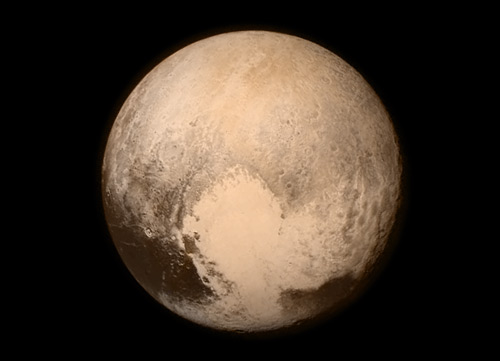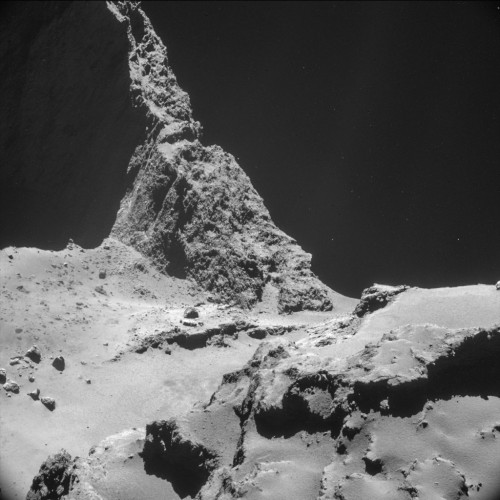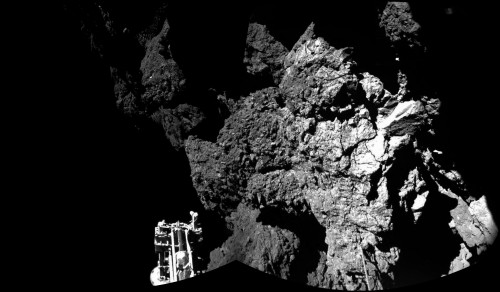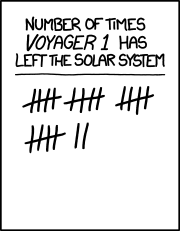Tag archives: space travel
Pluto fly-by: New Horizons sails past cold, distant world

Perfect view: the sharpest image of Pluto to date taken by the New Horizons spacecraft. (Courtesy: NASA)
By Tushna Commissariat
After trundling through our solar system for more than 10 years, NASA’s New Horizons mission made its closest approach to the dwarf planet Pluto earlier today, at 12:49 BST. It was a mere 12,472 km from the planet’s surface – roughly the same distance from New York to Mumbai, India – making it the first-ever space mission to explore a world so far from Earth.
If you want to find out more about the New Horizons mission, read this recent news story by physicsworld.com editor Hamish Johnston. Above is best close-up view of this cold, unexplored world that the spacecraft sent back before its closest approach (when it was still 766,000 km from the surface), revealing in clear detail many of the planet’s surface features, including the “heart” at the bottom.
View all posts by this author | View this author's profile
Last chapter in Rosetta’s Philae lander story…for now

Strange new world: Image of comet 67P taken by Rosetta’s NAVCAM from 10km away.
(Courtesy: ESA/Rosetta/NAVCAM, CC BY-SA 3.0 IGO)
By Tushna Commissariat
Last week was exciting and exhausting for anyone involved in space exploration and astronomy, after scientists working on the Rosetta mission of the European Space Agency (ESA) made history when their “Philae” module touched down safely on the surface of comet 67P/Churyumov–Gerasimenko. But soon after celebrating Philae’s successful landing, a dramatic story unfolded. With a bumpy triple landing, harpoons that did not fire and tether the probe, as well as a final resting spot that lay in the shadows, which meant its solar panels received very little sunlight, Philae’s tumultuous story captivated the interest of thousands of people across the globe.
In the early hours of Saturday morning, as Philae’s batteries slowly drained of power, thousands mourned. “So much hard work..getting tired…my battery voltage is approaching the limit soon now,” Tweeted the Philae crew, and yet, the lander’s story was ultimately happy and successful. Although it spent only 57 “active” hours on the comet, ESA mission scientists were happy to report that the lander had indeed completed the entirety of its primary science mission.
View all posts by this author | View this author's profile
Rosetta’s Philae starts drilling into comet surface

View of a lifetime: Philae safely on the surface of Comet 67P.
(Courtesy: ESA/Rosetta/Philae/CIVA)
By Tushna Commissariat
It had clearly been a long and busy 24 hours for members of the Rosetta mission at the European Space Agency (ESA) as they gave the latest updates in today’s Google+ Hangout. On Wednesday the mission made history as its “Philae” module touched down safely on the surface of Comet 67P/Churyumov–Gerasimenko. But there has been a great deal of drama and uncertainty since then, as it emerged yesterday that the lander’s final resting spot was more than 1 km away from where it was meant to arrive. Also, Philae is thought to be precariously positioned in the shadows on the far side of a large crater, where its solar panels cannot get enough light to operate as planned. Despite these hurdles, the lander’s many instruments have been functioning well and sending data back to Earth, via the Rosetta orbiter.
View all posts by this author | View this author's profile
Blood Moons, teachers who moulded the minds of great physicists and more

Jocelyn Bell Burnell on her high-school physics teacher. (Courtesy: Perimeter Institute for Theoretical Physics)
By Tushna Commissariat
This week has been an exciting and busy one at Physics World HQ, what with two Nobel prizes that included physics – the actual Nobel prize for physics, of course, as well as this year’s chemistry Nobel, which was given to three physicists. Since last week’s Red Folder was full of Nobel trivia and facts, I will only point you to two more interesting Nobel-related articles. The first is an excellent article on the Slate website, by one of our regular freelance authors Gabriel Popkin, where he looks at female physicists who deserve a Nobel. His list is in no way exhaustive, but does well to highlight some excellent work done by women that deserves recognition, so do take a look at “These women should win a Nobel prize in physics”. Also, Ethan Siegel from the Starts With a Bang! blog has written an excellent essay to silence any would-be naysayers about the worthiness of giving the Nobel to the researchers who developed blue LEDs. In “Why blue LEDs are worth a Nobel Prize”, he outlines the history of LEDs and talks about just how many applications they have in today’s times.
View all posts by this author | View this author's profile
Homework help from NASA, rescue missions, top technologies and more
By Tushna Commissariat
Who doesn’t like a bit of help with their homework – not 4-year-old Lucas Whiteley from West Yorkshire in the UK. When faced with some tough and rather complex scientific questions, the enterprising child filmed a video of himself asking the US space agency NASA for some help. And much to his delight, he got a video response courtesy of NASA engineer Ted Garbeff of the Ames Research Center in California. In the 10-minute video, Garbeff answers Whiteley’s questions including “How many stars are there?” and “Did any animals go to the Moon?” Of course, the story garnered nation-wide interest and was covered by the Huffington Post, the Telegraph and others. Take a look at Garbeff’s response video above.
View all posts by this author | View this author's profile
Sun-skimming comets, the future of the Space Race, scientists on record and more
By Tushna Commissariat
This week, professional astronomers and enthusiasts all over the world pointed their telescopes (and satellites) at the comet ISON as it raced towards the Sun and had its closest encounter with our star yesterday. Of course, the big question was whether the “Sungrazing comet” would survive its close call. Now, it seems that no-one is quite sure – early on, it looked as if the comet faded rather dramatically, suggesting that its nucleus disintegrated, and then it disappeared completely as it made its way through the solar atmosphere, making scientists mourn its fiery death. But lo, today a very faint smudge of dust was seen again, and seems to be brightening up once more. For now, researchers are referring to ISON as “Schrödinger’s Comet” and we may have to wait a while to know for sure. Right now, it seems that some of the comet has survived, but just how much of it made it through and if it will be visible in the sky in December is unknown. In case you missed all the action yesterday, take a look at Phil Plait’s Bad Astronomy blog, where he was posting live updates on the comet and Karl Battams’s blog on NASA’s Comet ISON Observing Campaign site, where he explains what happens next.
View all posts by this author | View this author's profile
Grumpy astronauts, LEGO overpopulation, videogame quantum mechanics and more
By Tushna Commissariat
This week, the Red Folder seemed filled to bursting with amusing and captivating news stories from around the web about physics. To start off, this rather hilarious and candid account of the Apollo 7 mission on the Discovery News website. I will not give too much away and let you read the story yourself, but suffice to say that having a rather bad cold while in space sounds dreadful and is bound to make the best of us quite grumpy – and I am sure the Apollo 7 crew would agree with me!
View all posts by this author | View this author's profile
Voyager 1, where art thou?
By Tushna Commissariat
It’s a running joke at the Physics World news desk – the exact location of the Voyager 1 probe and how often we end up writing about how it really has nearly left the solar system this time. So we decided to wait and watch when the news broke on Wednesday evening this week that the probe had left the solar system for sure (again).
Unsurprisingly, the next morning our inboxes included a slightly sheepish “status update” message from NASA. “The Voyager team is aware of reports today that NASA’s Voyager 1 has left the solar system,” says Edward Stone, Voyager project scientist based at the California Institute of Technology, Pasadena. “It is the consensus of the Voyager science team that Voyager 1 has not yet left the solar system or reached interstellar space. In December 2012 the Voyager science team reported that Voyager 1 is within a new region called ‘the magnetic highway’ where energetic particles changed dramatically. A change in the direction of the magnetic field is the last critical indicator of reaching interstellar space, and that change of direction has not yet been observed.”
Atlantis lifts off into history
By Tushna Commissariat
Despite gloomy weather conditions that threatened to cancel the launch altogether, NASA’s shuttle Atlantis has launched from the Kennedy Space Center. Marking the last and final flight of the Space Shuttle Programme – STS-135 – Atlantis and a four-person crew are on a 12-day mission to deliver more than 3.5 tonnes of supplies to the International Space Station (ISS). This final stock should keep the station running for a year. Although the countdown stopped briefly at 31 s before the launch, the shuttle had a “flawless” lift-off, according to NASA. It has now settled down into its preliminary orbit ahead of its rendezvous with the ISS this Sunday morning.
The image above is of the shuttle, taken shortly after the rotating service structure was rolled back yesterday at Launch Pad 39A at the Kennedy Space Centre in Florida (Credit: NASA/Bill Ingalls). Below is an image of the mission patch for this final iconic flight (Credit: NASA).

“The shuttle’s always going to be a reflection of what a great nation can do when it commits to be bold and follow through,” said astronaut Chris Ferguson, commander of the mission, from the cockpit of Atlantis minutes before the launch. “We’re completing a chapter of a journey that will never end. Let’s light this fire one more time, and witness this great nation at its best.”
Atlantis was the fourth orbiter built and had its maiden voyage on 3 October 1985. Atlantis had a number of firsts to its name – it was the first shuttle to deploy a probe to another planet, to dock to the ISS and the first with a glass cockpit! It conducted a final servicing mission to the Hubble Space Telescope in May 2009.
NASA has decided to retire its shuttle programme with this last flight because the vehicles are too costly to maintain. It now intends to contract out space transport to private companies. The hope is that this will free NASA resources to invest in a other programmes that will potentially send humans beyond the space station to the Moon, Mars and maybe even asteroids.
Atlantis is also carrying some rather unusual passengers – some simple yeast cells. The aim is to study the yeast cells as their genetic make up is remarkably similar to that of a human cell. This makes it an ideal system for studying genetic defects and understanding how these defects may manifest in human disease. In two separate experiments – conducted at the ISS – researchers will study the effect of microgravity on cell growth.
The video below has the crew of Atlantis talking about the “vibrancy of the ISS as a stepping stone for NASA’s plans for future human exploration beyond low Earth orbit”.
View all posts by this author | View this author's profile


